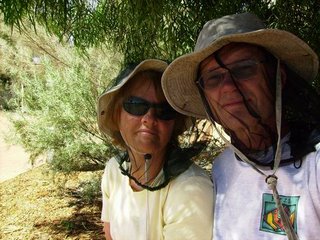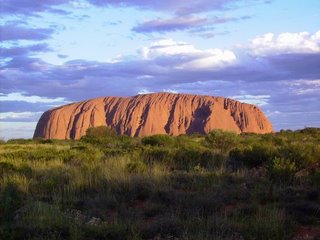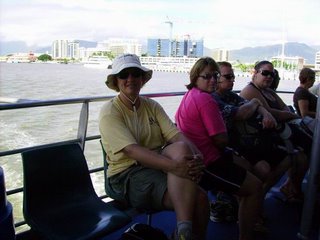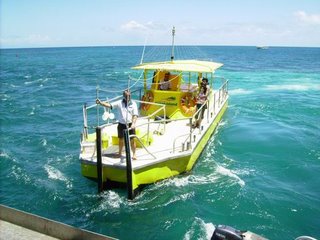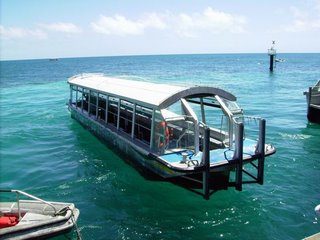We were picked up at our hotel at 7:30. There were 12 of us, plus 3 guides in a 21 passenger bus, so there was lots of room and it was quite comfortable. The guides were all around 30, plus or minus. Ros was the head honcho. She has 8.5 years experience as a guide. She has also guided in the Red Centre region (around Uluru) and the Kimberleys in Western Australia. She has been in this area for 2.5 years and we were to learn that she was very knowledgeable about the history, culture, flora, and fauna of the region. She and her partner have 4 camels. They are moving to the desert of the Red Centre where their camels will be more at home and where they will do guided camel tours for another company.
The other two guides, Steve and Greg, were trainees on a familiarization trip. They were not as expert as Ros on the local details, but they knew a lot and brought a wealth of other knowledge and great, fun-loving attitudes that kept things light and lively.
The first passenger we met was Norm from Calgary. He was pretty obviously retired, so I asked him how long and where he had worked. He said 5 years and at Moore Corporation (a business forms company). I asked if he knew Neil Schiissler. Of course, he had worked with Neil. Small world. We later met his wife Marie. Another pair was Pat and Julie, a mother and daughter combo from Kent, England. Pat was 50ish and Julie was a 25ish horsewoman show jumper who is getting married in May 2007. Another pair was Lisa and Renee, two 25-30 year olds from Minnesota. The other 4 were the Schwarz family (no relation), Holgar, Tina, Katrina (about 13), and Kristien (about 10) from Denmark.. The parents spoke very good English. Katherine had recently started taking it in school and Kristien had not started taking it yet. Apparently they have a lot of Danish tourists here ever since Prince Frederick started dating an Australian girl after the 2000 Olympics and married her about a year ago.
We left in a steady light rain with a forecast high of 29 and sunny. Sure enough, the rain soon stopped and the sky began to clear. It was mostly sunny through broken cloud for the rest of the day. The temperature where we were was more than 29 as the thermometer on my clock still said 30 degrees at 10 pm. And, of course, the humidity was high, making us perspire at the slightest exertion and perspire heavily on more challenging walks.
Our first stop was at the Fogg Dam. It was an earthen embankment about 4-6 feet high with a road on top that had been constructed many years ago to hold water for a failed rice plantation. The wetland it created is full of lilies and other water plants and all kinds of waterfowl. As we drove back across to our start point, we both noticed some bubbles near the base of the embankment that looked suspiciously like the bubbles the crocs made at the Australia Zoo, but there was no way of knowing for sure.
From the dam we drove to an interpretive centre that explained the history and ecology of the flood plain of the Adelaide River and more about the failed attempt to grow rice in the area. Then, a short stop by the roadside to check out some Cathedral termite mounds. Next stop – Mamukala wetlands, where a boardwalk led to an interpretive display. This is a large

slough/small lake that dries to a hard pan of mud in the dry season. The interpretive display showed the variations in flora and fauna between the seasons and how the aboriginal people found different food sources at different times of year. Then on to Jabiru for lunch at the place that would be our camp for the night. There is a large cooking and dining tent and a dozen or so two person tents furnished with two single beds each and a night table. Our site lies within a larger commercial resort with camping and cabin facilities.

After lunch we went to the Bowali Visitor Centre, the main one for the park. It had a lot of info on the ecology as well as the relationship of the aboriginals with the land. Very good. Next, we were supposed to go to Ubirr to see some rock art, but the road was closed due to flooding, so we went to another site at Nourlangie Rock

instead for some climbing walks to some art sites and lookouts. We then made a short stop at Nawurlandja Lookout for a look back at Nourlangie Rock and the escarpment in the distance.

Finally, we returned to the campsite. There we found a family of Curlews, mother, dad, and chick, had staked out the campfire ring. They weren’t too happy about our arrival, but eventually left. We picked the Curlew tent, thinking that would be a pretty good omen. We were pleasantly surprised to find that the flies and mosquitoes are not too bad at all. While our guides prepared supper, the whole gang of tourists retreated to the pool for a very refreshing dip.

Ros (the guide) used two expressions that captured the landscape I have described many times previously – savanna and open forest. Both describe the thin forest in a sea of grass that we have seen so often. We saw lots of it today. Leaving Darwin, there were quite a few mango orchards and some cattle grazing. Farther out, we ran into the flood plain of the Adelaide River. The river itself is about 50 metres across, but the flood plain extends for a kilometer or more on either side. At the height of the wet season, it can be a lake many miles long. Farther east we got out of the very flat flood plain and into slightly higher, but still pretty flat savanna. This is the home of the Cathedral termites who feed on the abundant grass that is 4 to 8 feet tall. Then, another flood plain, this time of the Mary River, then more savanna as we entered Kakadu, another flood plain of the Alligator River, and more savanna to Jabiru. East of Jabiru is the Arnhem Escarpment and some isolated outlying remnants of its former line. The escarpment is a cliff varying from 100 feet to 1,000 feet high running southwest from the coast.
They don’t have the same four seasons here that we do. They have “the wet” and “the dry” and two shoulder seasons. We are near the end of “the wet.” And boy, is it wet! Most dirt roads and some paved roads are closed because they are too wet or under water - in some cases several feet of water. Because the land is basically flat, there is a lot of standing water just about everywhere and all the creeks and streams are very full.
 Today was a very leisurely day with little travel and lots of swimming. We first stopped at a roadside interpretive centre for termite mounds. One type is called “magnetic” because the termites shape it like an aircraft wing and orient it north/south. Because of this, one side faces the sun in the morning, one side face it in the afternoon, but, in the middle
Today was a very leisurely day with little travel and lots of swimming. We first stopped at a roadside interpretive centre for termite mounds. One type is called “magnetic” because the termites shape it like an aircraft wing and orient it north/south. Because of this, one side faces the sun in the morning, one side face it in the afternoon, but, in the middle of the day the leading edge shades the rest. In this way they maintain a relatively constant temperature. There was also a huge cathedral mound, 5 metres tall and estimated to be about 50 years old.
of the day the leading edge shades the rest. In this way they maintain a relatively constant temperature. There was also a huge cathedral mound, 5 metres tall and estimated to be about 50 years old. Next stop, Wangi Falls. We couldn’t swim here because it is possible for crocs to reach here in “the wet,” but it is a popular swimming spot in” the dry.” We did a very nice walk across the top and down the other side through monsoon forest (like rain forest) at the bottom and savanna at the top. As we climbed up, there was also a clear definition of monsoon forest on our left and savanna to our right where it was less influenced by the falls and creek.
Next stop, Wangi Falls. We couldn’t swim here because it is possible for crocs to reach here in “the wet,” but it is a popular swimming spot in” the dry.” We did a very nice walk across the top and down the other side through monsoon forest (like rain forest) at the bottom and savanna at the top. As we climbed up, there was also a clear definition of monsoon forest on our left and savanna to our right where it was less influenced by the falls and creek.
 Our next stop was at Tollmer Falls. We couldn’t swim there because of a roosting area for some protected bats, but it was a pretty view.
Our next stop was at Tollmer Falls. We couldn’t swim there because of a roosting area for some protected bats, but it was a pretty view.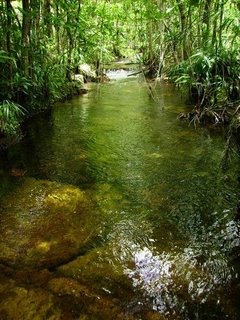 Next stop, Florence Falls, where we did a walk along the creek before taking a long swim in a very pretty rockhole. This place wasn’t as secluded as Moline Falls, but was every bit as pretty. And, once again, the water temperature was just right. Apparently this is a very busy spot during “the dry” with people from Darwin because you have to get up to these mountain polls to be safe from crocs.
Next stop, Florence Falls, where we did a walk along the creek before taking a long swim in a very pretty rockhole. This place wasn’t as secluded as Moline Falls, but was every bit as pretty. And, once again, the water temperature was just right. Apparently this is a very busy spot during “the dry” with people from Darwin because you have to get up to these mountain polls to be safe from crocs. 
 From there we hiked up to a lookout over the falls.
From there we hiked up to a lookout over the falls. Then it was just a short drive to Buley Rockholes, a series of small falls into small pools that lies above Florence Falls. We hung out there relaxing with lots of other people until it was time to head home. Also keeping us company was a 4-5 foot Michell’s Water Monitor, a harmless insect eater which is about half body and half tail.
Then it was just a short drive to Buley Rockholes, a series of small falls into small pools that lies above Florence Falls. We hung out there relaxing with lots of other people until it was time to head home. Also keeping us company was a 4-5 foot Michell’s Water Monitor, a harmless insect eater which is about half body and half tail. 
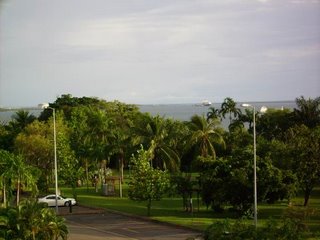 We got back to the hotel about 5:30 in time to take a picture of the harbour from our balcony.
We got back to the hotel about 5:30 in time to take a picture of the harbour from our balcony.















